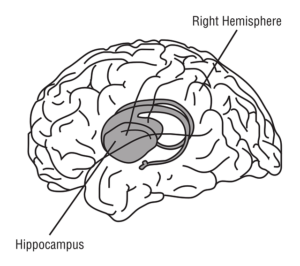When considering your important relationships and thinking about what makes the good ones good and the bad ones bad there may be lots of things that come to mind. You may look at the beliefs and values you share with your partner, you may consider the similar interests you share with a best friend, or perhaps it is a shared experience that brings you close or repels you from another person. But there is another essential area to consider when reviewing relationships that often gets overlooked.
The brain.
How often do you consider the impact your brain can have on your relationships?
Understanding the importance of our own brains may not be the first thing that comes to mind when asked about our relationships. But, the brain is the place where we process how we perceive, evaluate, understand, communicate and interact with other people. The brain is inextricably linked with behaviour and mental processes.
There are three specific brain structures that have the ability to affect our sense of well-being and can impact our relationships.
Without going into hugely complicated brain anatomy (!) the following areas are fundamental to helping us understand how this works.
Brain Structures and Emotions
Pre-Frontal Cortex
Where we begin. This is the most important brain structure.
If you can imagine looking down on a brain from above, the upper part is the cortex. The front half of this structure is the cortex. The front half of this half is then the pre-frontal cortex. If we’re on top form, this is where we will be working from. If the lights are on up there, we will be our best selves. We will be present and grounded, adaptive to others, responsive to other people’s needs, we are being “adults”. When the neurons are firing up in this section, we are on form!
Hippocampus
 If we go lower into the brain, we find the limbic system, this is the place where we regulate emotions and assess potential threats. There may be emotional communication going on, but it’s not happening right at the top of our brains, at a higher level. The hippocampus and amygdala are two important structures within the limbic system.
If we go lower into the brain, we find the limbic system, this is the place where we regulate emotions and assess potential threats. There may be emotional communication going on, but it’s not happening right at the top of our brains, at a higher level. The hippocampus and amygdala are two important structures within the limbic system.
The hippocampus modulates memory and processes sets of stimuli. It’s where we hold our autobiographical memory and from where can tell stories about ourselves. Our hippocampus is the part that will process aspects of emotional memories. Our memories are then what help us to respond to the world around us and inform what our emotional responses may be.
Amygdala
The amygdala is an almond-shaped structure lower down in the brain essential for decoding emotions. It is a more primitive part of our brain and modulates emotions directly linked to our survival such as threats or food. It is essentially the guard dog or internal alarm part of our brain.
This part is particularly important in responding to threats and many of our internal alarm circuits are found in the amygdala. As a result, it can detect threats from various sensory sources.
The amygdala also exaggerates threat on purpose. This is ideal when there is an actual threat as it helps us mobilise ourselves to keep ourselves safe. When we are activated in our amygdala it shoots out epinephrine, cortisol and adrenaline to get us active to save ourselves.
But, when there is so much focus down here, our pre-frontal cortex is essentially relegated and goes offline. Our brain is flooded and drowns out the pre-frontal cortex because in terms of biology, it’s not so important a structure in our threat response system. The amygdala and our internal threat system are going to be the brain structures keeping us out of danger. Our sophisticated pre-frontal cortex is great for rationale and higher level thinking but isn’t so necessary in keeping us safe. When our priority is reacting to an immediate threat, we don’t have time to weigh up the pros and cons of the options available to us, we just need to move quick! Thinking more or less goes out the window when what we need is to be ready for combat or to run as fast as we can.

So how do these structures come together to have an impact on relationships?
Our memories fuel our emotions
If we are in a car crash for example, the hippocampus will recall who we were with, what we were doing at the time etc. Because of the connections with the amygdala, we may then get sweaty palms and a racing heart beat too as our amygdala kicks in. If at a later date we are in the car with the same friend and a similar trigger situation occurs, we may find ourselves reacting in a very similar way even though this time we may not be at risk of an impending crash. Our system has been conditioned somewhat to this potential danger and we’re sent off on an emotional rollercoaster again as our hippocampus has been activated.
The hippocampus is important in building a theory about what works in relationships. If we recall a negative emotion we are likely to be taken to a negative mental space. If we recall happy memories we may be in a good mood. Positive memory recall entails the release of dopamine and in this way memory recall fuels our emotions.
The impact on relationships
It makes sense that if we have been in a destructive or abusive relationship, we are on heightened alert to similar situations. If we are used to operating at a level of increased self-preservation or increased anxiety, we may be at a constant level of a low grade threat response. Our reactions and emotions will therefore be informed by our previous experiences. We may find similar situations invoke a similar threat response with our pre-frontal cortex going offline even though the situation is different.
If we are at home awaiting the return of our partner and the door slams shut, if our threat system is activated we may respond in a jumpy way. Our limbic system will be activated and we may be responding to what we perceive to be a potential danger. We may snap at our partner and react angrily as our amygdala has flooded us with stress hormones. I might attribute my threat response to what is going on in front of me instead of understanding it in a more rational way. Perhaps my partner has let the door blown shut and I find myself reacting in response to what I perceive to be a major threat because I am remembering alarm bells from back in the days.
It’s Complex
This is just a simplistic look at how the brain impacts on our relationships. The connection between the brain and relationships are so closely intertwined that relationships can also actually have an impact on our brain. Our relationships have the power to also alter the structure and neural pathways in our brains.
Moving Forward
If you are interested in how you came to be the way you are, why you make decisions that you do and why you avoid making other choices in life, get in touch. Transactional Analysis therapy is an amazing way to aid understanding of ourselves, our personalities and our relationships.

